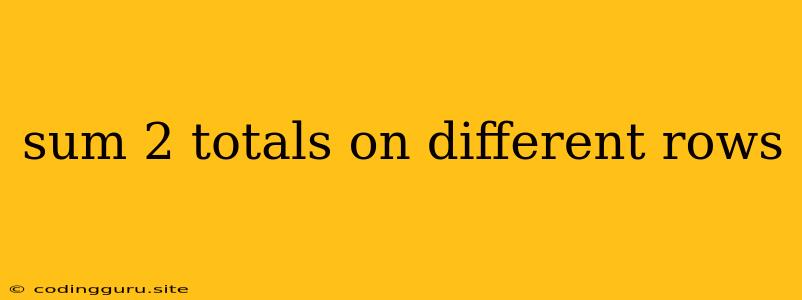Summing Totals on Different Rows: A Comprehensive Guide
In the realm of data manipulation, the need to sum values across different rows often arises. This task, while seemingly straightforward, can be tackled in various ways depending on the specific context and tools at your disposal. This article aims to provide a comprehensive guide on how to sum totals on different rows, delving into different methods, their advantages, and limitations.
Understanding the Need for Summing Totals
The requirement to sum totals across rows frequently occurs when dealing with datasets where individual rows represent distinct entries or records. For example, in a sales report, each row might represent a single transaction with the total sale amount. When you need to calculate the overall sales for a particular period, you need to sum the individual transaction totals on different rows.
Popular Approaches for Summing Totals on Different Rows
1. Using Spreadsheet Software (Excel, Google Sheets):
For simple data sets, spreadsheet software like Microsoft Excel or Google Sheets offers an intuitive and readily available solution.
Steps:
- Identify the cells containing the individual totals you want to sum.
- Use the SUM function: In Excel, type "=SUM(" followed by the range of cells containing the totals, then close the parenthesis and press Enter. For example,
=SUM(A1:A10)will sum the values in cells A1 through A10. - Alternatively, use the AutoSum feature: Select the cells containing the totals, click the "AutoSum" button (Σ), and Excel will automatically insert the
SUMfunction with the correct cell range.
Advantages:
- Simplicity: Spreadsheet software provides a user-friendly interface for summing values.
- Visual Representation: You can easily see the data and the calculated sum.
- Flexibility: You can apply additional calculations and formatting.
Limitations:
- Limited Data Volume: Handling large datasets can become cumbersome and slow.
- Lack of Automation: Manual operations might be required for repetitive tasks.
2. Using Programming Languages (Python, R):
For more complex tasks, programming languages like Python or R offer greater flexibility and automation capabilities.
Python Example:
data = [10, 20, 30, 40, 50]
total_sum = sum(data)
print(f"The sum of the values is: {total_sum}")
R Example:
data <- c(10, 20, 30, 40, 50)
total_sum <- sum(data)
print(paste("The sum of the values is:", total_sum))
Advantages:
- Automation: Scripts can be written to handle repetitive tasks and large datasets.
- Advanced Calculations: Programming languages allow for complex computations and data manipulation.
- Integration with other Tools: Data can be processed and integrated with other software and databases.
Limitations:
- Learning Curve: Programming requires basic programming knowledge.
- Setup and Configuration: Setting up the necessary libraries and environment might be needed.
3. SQL Queries:
In databases, SQL queries provide a powerful mechanism for data aggregation and manipulation.
SQL Example:
SELECT SUM(total_amount) AS total_sales
FROM sales_transactions
WHERE transaction_date BETWEEN '2023-01-01' AND '2023-03-31';
This query selects the sum of the total_amount column from the sales_transactions table for transactions occurring between January 1st and March 31st, 2023.
Advantages:
- Scalability: Suitable for handling massive datasets.
- Data Integrity: Ensures consistent and accurate results.
- Integration with Databases: Directly interacts with database systems.
Limitations:
- SQL Knowledge: Requires knowledge of SQL syntax and database concepts.
- Database Access: Access to the database and appropriate permissions are necessary.
Choosing the Right Method
The choice of method depends on factors such as:
- Data Size: Small datasets can be managed using spreadsheet software. Large datasets benefit from programming languages or SQL queries.
- Complexity: Simple sums can be done in spreadsheets. Complex calculations or conditional sums often require programming languages.
- Automation: If you need to perform the sum repeatedly, consider using programming languages or SQL for automation.
- Data Source: If the data is stored in a database, SQL is the preferred choice.
Additional Tips
- Verify Data Accuracy: Before performing any sum, ensure that the data is accurate and consistent.
- Use Clear Naming Conventions: Assign meaningful names to columns and variables for better readability.
- Document Your Code: Include comments to explain your logic and steps, especially for complex operations.
Conclusion
Summing totals across different rows is a fundamental task in data analysis. By understanding the various approaches available, you can select the most efficient and appropriate method for your specific needs. Whether you utilize spreadsheets, programming languages, or SQL queries, choosing the right tool and applying best practices will ensure accurate and reliable results.
